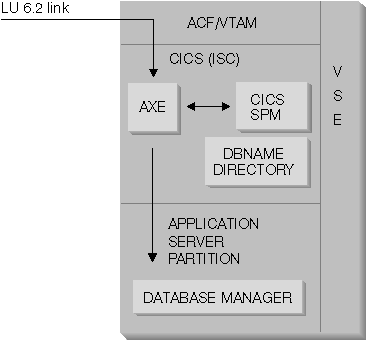

In the VSE/ESA operating environment, DB2 for VSE provides the application server function in a DRDA environment. The application requester function is not provided. The various DB2 for VSE and VSE components involved in distributed database processing are described in this section. These components enable the DB2 for VSE database management system to communicate with remote DRDA application requesters in an SNA network.
Figure 35 shows how each component plays a role in establishing communications between the DB2 for VSE Application Server and the remote Application Requester.
Figure 35. Gaining Access to the Application Server
|
The application requester issues an APPC ALLOCATE verb with a specific LU name and transaction program name (TPN) to establish an LU 6.2 conversation with the application server. The LU name is used to route the ALLOCATE request through VTAM to CICS. Upon receiving the ALLOCATE verb, CICS verifies that an AXE transaction is defined with that TPN, and performs a CICS sign-on. If the conversation security level for the CICS connection is VERIFY, both user ID and password are expected from the application requester, and are used in the sign-on. The CICS sign-on table (DFHSNT) must be updated with this user ID and password so that the connection is accepted. If the security level is set to IDENTIFY, only the user ID is required, and CICS entrusts the security check to the remote system. If the security check is successful, CICS starts the AXE transaction to route requests and replies between the application requester and an application server. The TPN used by the application requester must also have an entry defined in the DB2 for VSE DBNAME directory that points to an operating DB2 for VSE server within the VSE system.
If the application requester wishes to take advantage of distributed unit of work support, it specifies a SYNCLVL of SYNCPT on the APPC ALLOCATE verb. When the AXE transaction has started, it queries CICS to determine the SYNCLVL of the conversation. If it is SYNCPT, it does the following:
Unlike its VM counterpart, the DB2 for VSE application server accepts DRDA flows from remote application requesters. Private protocols are not supported. As a result, VM application requesters cannot access a VSE server with PROTOCOL=SQLDS.
The DB2 for VSE DRDA server cannot route requests from remote application requesters to a DB2 for VM server using VSE guest sharing. Such requests should be sent directly to the DB2 for VM DRDA server.